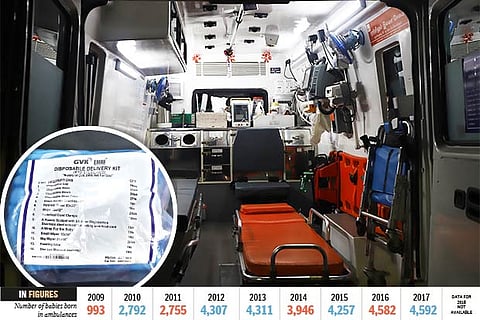

Chennai
By the time the 108 ambulance service received the call from Banumathi’s husband Srinivasan and despatched its crew, the 26-year-old was already in severe labour pain. When they reached their house in Sembur, a tribal village in Salem, the medical technicians found that it was already time for delivery. They rushed her to the nearest government hospital which was more than 17 km away from there. But along the way, on that narrow, hilly road, was a tapioca-laden lorry that had broken down.
It was a real crisis, perhaps even a matter of life and death, as any further delay could have proven life-threatening. The emergency medical technicians (EMT) had to take a decision – and they took the call to perform the delivery, before the mother and new-born boy were taken to the Primary Health Centre.
This is not an isolated case: 11 years since the service commenced in the State, the EMTs on board these ambulances have performed more than 35,000 deliveries. The GVK Emergency Management and Research Institute (EMRI) conducts training sessions to prepare the technicians to perform deliveries. The vehicles, too, have all the medical equipment required for this.
However, even as such heart-warming stories of lives being saved by EMTs abound, doctors warn against deliveries in ambulances, insisting that they should be performed only at healthcare facilities fully equipped to handle such cases.
According to doctors, it is the delay in informing the 108 ambulance service that has made the incidents of deliveries being conducted by EMTs so very common.
There are even cases where the ambulance is called only after the family finishes rituals like hot bath and prayers when the pregnant woman develops labour pain.
Risks and challenges: “The technicians are trained and ambulances are equipped to perform such deliveries. But there could be complicated cases like when umbilical cord wound is around the neck of the child or the position of the child is not normal.
It is very risky to undertake such deliveries outside a hospital set up. Delivery preparedness is an eight-hour process; there is enough time to call an ambulance and take the pregnant woman to the hospital,” said Dr Siva Gurunathan, head of emergency training centre.
There are unforeseen circumstances that could further complicate the matters.
For instance, in Banumathi’s case, the stalled lorry that blocked the road meant the ambulance could not proceed before the vehicle was repaired. As the episode was being played out around midnight, this would take hours together. Making matters worse, there was no mobile network, which meant the crew could not immediately update the superiors about the crisis they were facing.
Finally, the ambulance driver Stalin ran about a kilometre to find a spot with connectivity and asked another ambulance to be rushed to the spot. After the delivery, the mother and child were shifted to the other ambulance stationed on the other side of the broke down lorry and then taken to Karumanthurai PHC.
“The ambulance needs time to reach the spot and rush the pregnant woman to the hospital. But we get calls only half an hour from the delivery. Public should not mistake EMTs for doctors and ambulances for hospitals,” said Balaji Premnath, marketing head, GVK EMRI, urging the people to not delay in approaching the ambulance service.
Training the EMTs and equipping the ambulances: At the time of their induction, all emergency medical technicians are imparted training by GVK EMRI instructors on performing deliveries.
“We provide 45 days of training, including using dummies, to explain the procedure to the medical technicians. If there are any signs of complications, the EMT is not supposed to attend to the delivery but take the woman to the hospital.
However, they perform delivery when they do not have an alternative. So far, there are no unsuccessful cases that have been taken up by EMT,” said R Anita, instructor for emergency medical trainers.
The 108 ambulances are equipped with complete medical and pregnancy kit that includes obstetrics and gynaecology medicines, including oxytocin and others, IV fluids and suction pump. The delivery kit includes surgical blade, gauge pad to offer support, towel, plastic cover, mucus extractor, clamp, towel to wrap the baby. The EMT members carry multiple kits if the history shows sign of twin children.
All the details on the child and the mother attended is recorded in a form that includes date and time of birth, and the procedures adopted for the delivery. Meanwhile, doctors will be in constant touch with the staff to guide on the delivery process during the course of the procedure.
The four key stages
The routine and redline:
When they receive a call to transport a pregnant woman for delivery, the 108 call centre collects vital details about the patient – known in medical parlance as GPLDA: Gravida – number of times a woman has been pregnant; Previous deliveries by the woman; Live births among them; Deaths, if any, during pregnancy or post-delivery; and Abortion, if any. Other details like age and labour pain status are also enquired so that the technicians are prepared to attend to any complications. The EMTs are not supposed to attend the delivery of a woman who has had caesarean for the previous child. In case of death of previous child during delivery, the case is not attended. However, if the woman has suffered abortion previously, the delivery is performed. If woman has unstable blood pressure, diabetes, seizure and other complications, the case is not taken up by EMT.
(as explained by R Anita, EMT instructor)
Visit news.dtnext.in to explore our interactive epaper!
Download the DT Next app for more exciting features!
Click here for iOS
Click here for Android